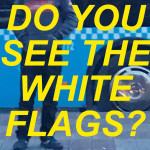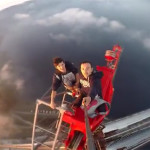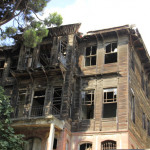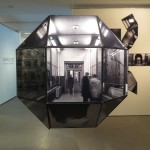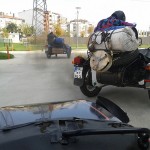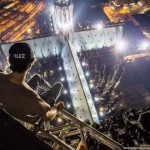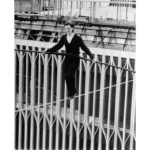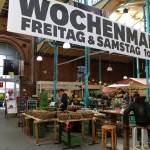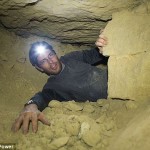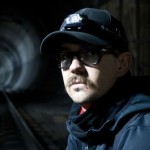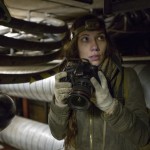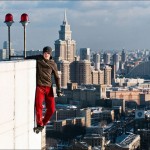Urban Exploration
Thomas BüschThe artist in residence from Austria – Maurizio Cirillo – will have a performance at Aksaray, Istanbul on Saturday February 23, 2018 between 11 am and 6 pm. Maurizio Cirillo lives and works since December in Istanbul. Maurizio Cirillo’s artistic practice, consisting of objects, photographs, videos, drawings and prints, could be seen as an on-going research on everyday life.
Performance by Maurizio Cirillo: Staying on the Platía Omonías in Athens for five days at a previously determined time span. 2013
The feeling of defencelessness and helplessness to the point of unconsciousness. We want to understand, to comprehend and fail miserably. In his work „Aksaray. Do you see the white flags?“ he wants to trace these feelings. Seemingly without plan, he will spend time on the square. he simply stand there, sunk in himself. In his presence, I is absent. He will show nothing, nothing concrete at least, only his physical presence. He surrenders himself, so to speak, to the urban space. He will take his place on the big square next to Aksaray Metro İstasyonu just come by and join him to experience the square!
His fellowship in Istanbul is part of the program of the Federal Chancellery of Austria. The Federal Chancellery of Austria awards four grants per year to Austrian artists in the framework of an abroad studio program. The artists use the time in Istanbul to realize projects in an international context, gain new inspiration and extend their networks.The cultural initiative diyalog, as the program’s partner, introduces the awardees to the arts scene. Through its network it offers them the opportunity to examine current artistic trends and exchange ideas with other artists and curators.
With a support of
[...]
Read more...
Maximiliane SchneiderIstanbul gets a 3rd Bosporus Bridge, connecting the European and Asian side. The construction is still in process but anyway had its first civilian visitors lately: Two extreme climbers clambered up the construction cranes and offered us a breath-taking view over the bridge – a view, the world’s public won’t even see after the bridge’s opening for public transportation.
The two young guys, who can be seen in the video, are Pavel Smirnov and Özcan İpar. Both of them climbed up without any safety harness. Indeed quite the opposite could be seen in the video: Both of them seem more than easy-going and relaxed over the whole full-length of the film clip. Videos like this can be seen as politically statements. Indeed the 3rd Bosporus Bridge, also named after Yavuz Sultan Selim better known as Selim I., suggests this assumption as the project meets with lots of criticism. Environmental organisations and activists do fear things like ecological destruction and a rising traffic amount. But in the first place, spread videos like the one shown belong to movements like buildering, open exploring, place hacking and extreme climbing.
Nowadays this kind of sport and interest is practised all around the world and even youngsters, like the Russian Marat Dupri, are attracted by the sport and its adrenalin rush. Entering urban spaces illegally and clambering high buildings like skyscrapers without any safety measures; it’s gambling with one’s own life but besides this thrill it’s also about self-expression – as the whole world is watching through selfie pictures and video clips.
[...]
Read more...
Katharina SchmidtOnce the dominant style of İstanbul’s housing, the traditional wooden buildings are more and more vanishing from the city landscape: Untill the middle of the 20th century wood – due to its cheap supply – was the mainly used material in construction. Devastating fires that haunted the city at the turning of the 20th century lead the government to forbid further construction in wood. Although experts argue that the closeness of the houses and not the material was the cause of the fire’s violence, wooden construction was abandoned. Starting from the 1920s foreign minorities who represented the majority of the craftsmen started to leave Turkey, taking the knowledge of the craft with them. Modernist aspirations of the turkish population that favoured european style housing in concrete furthered this development. A whole architectural type and with it artcrafts that dates back untill the 16th century is slowly erased.
Now it is becoming very rare to see these old houses – most of them in a devastating state standing lonely between a range of faceless row houses at least two floors higher than them. The owners, often poor migrants who moved in after the middle class left the districts in order to live in more fashionable quartiers, can mostly not afford to maintain the houses. However investors simply await their collaps in order to build a whole new apartment – with more floors that generate more profit.
The houses don’t only stand out due to their typicall “cumba” and bay windows but also thanks to their picturesque beauty that remind of the city’s historic past. Strolling through the streets of the districts Süleymaniye, Zeyrek, Ortaköy on the european or Kuzguncuk and Kadıköy on the asian side one can still find some relicts of an old İstanbul that didn’t yet follow the logic of neoliberal urban development. [...]
Read more...
Thomas BüschBook Launch and Exhibition – the upcoming artist in residency from Berlin in Istanbul will have a book launch and exhibition in Berlin, February 19th 2015, 7 pm at Revolver Publishing Immanuelkirchstraße 12, Berlin. Katja Pratschke together with her husband, the filmmaker and artist Gusztáv Hámos will be in Istanbul starting in March 2015:
The exhibition Sample Cities / Imaginary Spaces deals with the theme of personal urban perceptions, which we call »the city«. The city, as a living organism, reflects social processes and interactions, economic relations, political conditions and private matters. In the city, human memories, desires and tragedies find expression in the form of designations and marks engraved in house walls and paving slabs. The Sample Cities/ imaginary spaces project researches what is contained or concealed in the city under this layer of signs.
The source material for the installation consists of photo works by Gusztáv Hámos, produced between 1973 and 2012, each of which sequences depicts essential situations of urban experiences containing concentrations of human and inhuman acts in a compact form. The cities in this exhibition include Berlin, Budapest and New York. Places with a traumatised past: (cold) war, dictatorships and terrorist catastrophes.
For the exhibition, 9 photo sequences have been assembled into tableaux or series of images and a three dimensional photo object. Every individual photo work already contains within it an idea, an arrangement, a programme, a concept – as scores and notations. Sample CitIES/ imaginary spaces is inspired by Italo Calvino’s book »La città invisibili«, (»Invisible Cities«). Each video outlines an imaginary city that summarises an historic, social, economic, political or private aspect in a poetic narrative.
Video Credits: Narrator – Ulrich Matthes | Music – Chopin | Drums – Thomas Wydler | Vocals – Karolina Ferencz
Learn more about Hidden Cities and Sample Cities at potentialspace by Gusztáv Hámos and Katja Pratschke.
Katja Pratschke is the artist in residence in Istanbul by the Berlin Senat starting March 2015 – .
[...]
Read more...
Markus Schmidtleavinghomefunktion: 5 People + 5 Ural Motorcycles + 2 Years + 30.000 Kilometres
In September 2014 five young artists from Halle, Germany, started a two-years trip from Germany to New York City on the landway. – They are using old Russian Ural motorcycle going East to get to the West. They will cross 23 borders and will cover a distance of 30,000 kilometres. InEnArt met the five artists on their two-days stay in Istanbul.
Road of Fame
The journey is not a way to get a break of daily life; they intend to get new impulses and they want to exchang experiences with other cultures to overcome clichés and get connected to build up a community. It is their way to broaden their own horzions, get first-hand informations and questioning themselves “how do I handle the situation?”. Through these experiences they want to create a social project. The biggest challenge lies in advantage of rearranging one’s own preceptions of cultural and social space constructions.
That is why we decided to do this in two years to get a deeper insight, mentioned Elisabeth Oertel.
Johannes Fütsch, Sven Klatt and Lisa Müller, Elisabeth Oertel and Anne Knödler
They left their familar terrain entering an adventures of the unknown.
We use the motorcycles as a medium to get in contact with our social environment, said Anne Knödler.
They decided not to be a studio artist but expand their art practice into a mobile and intercultural art project.
Two wheels with sidecar
The Ural motorcycle is a cross-country vehicle which is also used and much appreciated in Georgia, Kazakhstan, Mongolia and Russia. This type of motorcycle with a sidecar is a traditional means of transportation in many places there. It is generally considered robust, anyone can repair it and when necessary they can provide us with spare parts, yet it is said that these machines break down from time to time.
The motorcycle makes the difference
We opted for these old Russian motorcycles since for us the journey itself is the main issue
Follow the Trip
By keeping us up-to-date they are documenting their trip via filming, photographing and writing and publishing it regular at leavinghomefunktion.
The next stop on the trip will be in a small village in Georgia where they are going to stay six-month isolated from the civilization.
[...]
Read more...
Thomas BüschIllegal Photographs That Urban Climbers Risked Their Lives To Take
Urban explorers or place hacker are groups of young people illegally scaling buildings around the world to take the most incredible, heart-pounding, vertigo-inducing, one-of-a-kind shots of cities from vantages rarely seen.
Russian teenager Marat Dupri began scaling buildings and other high-rise structures in Moscow to take landscape photographs as early as 2011. In September of that year, several of his photographs were featured on news sites including the Daily Mail.
A video of Dupri and his friends scaling a freestanding structure for photographs was first uploaded to YouTube on January 7th, 2012, by DeAeMe. A photo taken while this video was being filmed won an award in the 2012 Best of Russia photography competition.
[...]
Read more...
Thomas BüschPhilippe Petit was crossing illegally the space between the two towers of the World Trade Center in August 1974.
Petit’s most famous performance was conducted on a wire between the roofs of the Twin Towers of the World Trade Center in Manhattan, a quarter mile above the ground. He performed for 45 minutes, making eight passes along the wire, during which he walked, danced, lay down on the wire, and saluted watchers from a kneeling position. Office workers, construction crews and policemen cheered him on.
On the street below, people stopped in their tracks — first by the tens, then by the hundreds and thousands — staring up in wonder and disbelief at the tiny figure walking on air between the towers. Sgt. Charles Daniels of the Port Authority Police Department, dispatched to the roof to bring Petit down, looked on in helpless amazement. “I observed the tightrope ‘dancer’ — because you couldn’t call him a ‘walker’ — approximately halfway between the two towers,” he later reported. “And upon seeing us he started to smile and laugh and he started going into a dancing routine on the high wire. And when he got to the building we asked him to get off the high wire but instead he turned around and ran back out into the middle… He was bouncing up and down… His feet were actually leaving the wire and then he would resettle back on the wire again… Unbelievable really…
After the performance Philippe Petit gets arrested [...]
Read more...
Johanna FröhlichThe project Markthalle IX in Berlin successfully counteracts gentrification by reactivating a historical building. Today, the Markthalle IX is a location that provides space for local entrepreneurs and initiatives to offer their products and to spread their ideas. It accomplishes to serve as an urban space that combines countryside living, slow food and intimacy with the values of 21st century city life and diversity in supply and culture. The Markthalle IX is over 120 years old and was originally inaugurated on October 1st in 1891. It is one out of three remaining market halls in the city and unique in its current utilization as fusion of individual business, local market and meeting point. It was reopened in 2011 and further extends its offers since then.
Kreuzberg, Berlin back in 2009. The heart of the capital´s arts and culture scene beats here. Over the past years, galleries, entrepreneurs and a series of in vogue- and independent (coffee) shops settled in the former sink estate and turned it into Berlin´s scene quarter. But one significant building was left out of this transformation. By that time, the Markthalle IX was home to discounters such as Aldi and Kik and the city planned to further expand the supermarket center. Luckily, three visionaries and local residents managed to hold up the negotiations and developed a plan on the future of this urban space.
Nikolaus Driessen, Bernd Maier and Florian Niedermeier, who run the Markthalle today, put all their passion and time in the realization of their project. They developed a plan on how to retransform the rundown building into its former utilization as lively point of trade, exchange and experience. After two years of negotiations and efforts at persuasion, the Markthalle IX was reopened in 2011 and hosts now a weekly farmers market on Fridays and Saturdays. It aims to promote predominately regional and seasonal products, small businesses and local buying opportunities.
Besides the weekly market, the Markthalle has permament fixtures such as a bakery, a fish and meat smokehouse, a small in-house brewery and a cafeteria. On thursdays, the Markthalle IX opens its door to host the so called Street Food Day. It promotes the multicultural diversity of Berlin´s food scenery on a more sophisticated scale than Döner and Currywurst. In addition to its function as a center for the manufacture and sale of produce, the Markthalle also serves as a platform for projects revolving around the subjects of nutrition, city living, agriculture, biodiversity and the environment.
The markthalle is a paragon of modern city planning and an example that gentrification does not always come along with negative side effects. It shows how a place can turn from an uncultivated leftover of good times with unattractive businesses to a highly innovative urban space that follows the trend of sustainability and consciousness for food.
Markthalle IX
Eisenbahnstrasse 42/43
10997 Berlin-Kreuzberg
[...]
Read more...
Thomas BüschThe news that New York based journalist Matthew Power died on March 10th at age 39 while on assignment in Uganda prompted an outpouring of grief from the media world.
Many fellow journalists felt a strong connection to Power, a skilled writer and reporter who not only had an enviable career writing in-depth articles from locations near and far.
Matthew Power in London 2012; Photo Bradley Garrett
Power was accompanying the British explorer Levison Wood while he attempted to walk the length of the Nile. Power was only dropping in and walking with him for a week, but you got the sense that he’d trudge on as long as it took to get the story and to understand the man he was walking with. On Monday, Power fell ill, lost consciousness, and died a few hours later. His travel companions believe the cause of death was heatstroke, but we won’t know more until an autopsy is completed later this week.
Levison Wood – Walking The Nile, March 2014; Photo Tom McShane
The Urban Explorer Bradley Garrett was supposed to meet Power at Heathrow Airport on the 17th August 2012 – Power was flying from New York and Garrett was flying from Cambodia, landing times synced. But Garrett’s plane was halted on the tarmac and he was arrested by British Transport Police, who had read his PhD thesis and wanted access to his research materials. Power waited three hours for him before deciding he had been burned and took a cab to Garrett’s flat in London…
Read what happened at Bradley Garrett’s site.
Later Power wrote a beautiful piece in GQ about Bradley Garrett, Place Hacking and Urban exploration.
Excerpt of his text Excuse Us While We Kiss The Sky at InEnArt
Matthew Power; Photo Bradley Garrett
In one of his last pieces, published in Outside, Power had traveled to Costa Rica to investigate the killing of Jairo Mora Sandoval, a 26-year-old conservationist murdered by poachers as he tried to protect leatherback turtles.
[...]
Read more...
Thomas BüschBradley Garrett was returning from a monthlong study project in Cambodia, and seeing his adopted city of London again he thought about all the incomparably strange and wonderful things he had witnessed there over four years—all the dizzying heights and hidden depths.
The 747 touched down and taxied, its passengers cramped and bleary after the thirteen-hour flight. But when the aircraft reached the gate, its doors didn’t open. After several minutes, the pilot came on the intercom, and Garrett fired off a tweet: “Just landed at Heathrow and we are told the police are boarding our aircraft. Welcome home. x”
A group of uniformed officers from the British Transport Police entered the plane and came down the aisle. They stopped at his seat, 42K. “Dr. Garrett?” “Yes?” “We need you to come with us.” An officer gripped each arm, and they led him down the aisle, past scores of wide-eyed passengers. In first class, former British prime minister Gordon Brown was furious over the delay.
Photos – Bradley Garrett
Garrett was handcuffed and led through passport control, where his ID was seized. Fingerprints, mug shots, and DNA swabs followed. He was eventually led to a holding cell and then an interrogation room. There he was not formally charged but was informed that he was being investigated for burglary, property destruction, and criminal trespass, among numerous other possible charges. He was told he had been the subject of a manhunt by the British Transport Police.
….
But it was his doctoral research itself that was perhaps most punk rock. His dissertation in human geography, which he had defended the previous year, was entitled “Place Hacking.” The title came from his argument that physical space is coded just like the operating system of a computer network, and it could be hacked—explored, infiltrated, re-coded—in precisely the same ways. He conducted a deep ethnographic study of a small crew of self-described “urban explorers” who over several years had infiltrated an astonishing array of off-limits sites above and below London and across Europe: abandoned Tube stations, uncompleted skyscrapers, World War II bomb shelters, derelict submarines, and half-built Olympic stadiums. They had commandeered (and accidentally derailed) an underground train of the now defunct Mail Rail, which once delivered the Royal Mail along a 23-mile circuit beneath London. They had pried open the blast doors of the Burlington bunker, a disused 35-acre subterranean Cold War-era complex that was to house the British government in the event of nuclear Armageddon. The London crew’s objective, as much as any of them could agree on one, was to rediscover, reappropriate, and reimagine the urban landscape in what is perhaps the most highly surveilled and tightly controlled city on earth.
The catch-all term for these space-invading activities is “Urbex,” and in recent years it has grown as a global movement, from Melbourne to Minneapolis to Minsk. The Urbex ethos was, in theory, low-impact: no vandalism, no theft, take only photographs; as one practitioner put it, “a victimless crime.”
……
First published by Matthew Power at GQ Magazine Online, March 2014 – Read the full story at GQ
[...]
Read more...
Thomas Büsch
Photos Bradley Garrett
In his newly published book, EXPLORE EVERYTHING: PLACE-HACKING THE CITY, the author and British urban explorer Bradley Garrett describes the appeal and background behind many place hackers motivaion to take the risk that comes with urban exploration:
London is, by many accounts, the archetypal, impenetrable fortress city. The financial district is circumscribed by a ‘ring of steel’, a security and surveillance cordon surrounding the City of London , and heightened security measures were reinforced by 9/11 in New York and the 7/7 Tube bombings. The construction of these types of spaces has meant that the security architecture familiar in airports and at international borders – such as cameras, cordons, bollards and even biometric readers – has begun to appear in our neighbourhoods. Over the past four years, the city has seen countless reasons to increase security measures in order to match an imaginary ‘threat level’: the Pope’s visit, the Royal Wedding, the Queen’s Jubilee, the 2012 Olympics. And yet after each of these events ends, the security levels remain ‘heightened’; the surveillance infrastructure remains in place.
Ironically, it is exactly these types of places that are most permeable to the urban explorer, because the more complicated a system becomes, the more weaknesses there are to exploit. As Dan Salisbury, another London explorer, told me, ‘At some point you have to say: “Fuck the consequences, I need to connect with this city, and if I have to work a little harder for that feeling, then so be it.”’
Urban explorers countermand those securitisation and distraction efforts through trespass, reporting back to the public with blogs, photos, videos and prose, bringing the hidden to the fore.
Order the Book Explore Everything from Amazon.
Crack The Surface – Episode II – Episode II takes a look at a small collection of explorers from across the pond in America and Canada, focusing on their participation and experiences within their local and global exploring community.
Visit Bradley Garrett on his page [...]
Read more...
Thomas BüschOne of those urban explorers pushing the boundaries is the Russian Vadim Makhorov, who goes above and beyond for a stunning photograph while he is traveling across Asia and Europe as a place hacker and photographer.
[...]
Read more...

